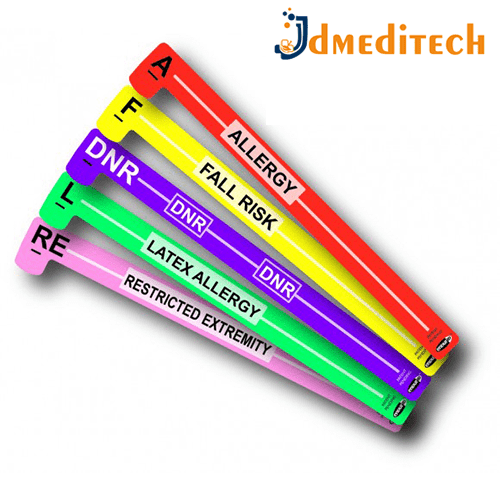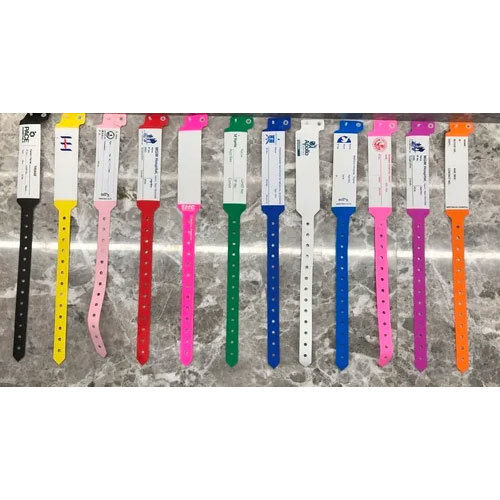How a Patient Identification Band Improves Patient Treatment and Reduces Hazards
Wiki Article
Discovering the Different Sorts Of Patient Identification Band Utilized in Medical Facilities
In the intricate globe of health care, the important role of Patient Identification bands frequently goes unnoticed. These bands, differing from basic paper wristbands to advanced RFID bands, create the foundation of Patient safety and security methods, guaranteeing precision in Patient Identification. Yet, the substantial diversity of these bands, each with its unique advantages and restrictions, is often forgotten. As we browse through this subject, one may obtain insight right into the subtle intricacies and crucial relevance of such bands in medical centers.Recognizing the Relevance of Patient Identification Bands
While they may appear like plain accessories, Patient Identification bands play a vital function in clinical centers. These bands act as an important tool for verifying Patient identification, preventing medical mistakes connected to misidentification. The bands generally show crucial information such as the Patient's name, age, blood group, and any kind of well-known allergies. They allow health care specialists to promptly access this important details, thereby helping with timely and precise clinical therapy. Patient Identification bands additionally help in streamlining administrative tasks, guaranteeing accurate record-keeping and invoicing. In spite of their simplicity, these bands personify the concept of Patient safety and security, a cornerstone of quality healthcare. Without them, the risk of clinical mistakes, and subsequently, Patient injury, may substantially boost.Traditional Paper Wristbands: Their Use and Limitations
Typical paper wristbands have actually been a staple in Patient Identification throughout various medical centers. While their usage is widespread, they nurture specific restrictions that may influence their efficiency in Patient monitoring. This section will concentrate on the range of their application and the inherent downsides related to their use.
Paper Wristbands: Use Scope
In the world of Patient Identification, paper wristbands have long held a vital duty. These bands are generally used in outpatient setups, where the Patient's stay is short-term. In spite of improvements in modern technology, the humble paper wristband remains a reputable and economical solution for Patient Identification in various healthcare scenarios.Limitations of Paper Wristbands
Despite their extensive usage, paper wristbands are not without their drawbacks. Their physical sturdiness is among the considerable restrictions. Exposure to water, sweat, or misuse can render them unreadable or perhaps cause them to disintegrate. Furthermore, paper wristbands usually do not have the technical abilities of more contemporary alternatives, such as barcoding or RFID chips, limiting their capability to just showing composed information. The inability to upgrade or change the data on the wristband is one more shortcoming. If the details is handwritten, legibility can be endangered, leading to prospective misidentification. Paper wristbands can trigger discomfort or skin inflammation to some clients, specifically when used for extended durations.Barcoded Wristbands: Improvements in Patient Identification
While Patient Identification has actually long been an important aspect of health care, the advent of barcoded wristbands symbolizes a significant leap onward. These bands leverage the simpleness of barcoding modern technology, enabling Patient details to be rapidly checked and accessed. They enhance the speed and precision of Patient Identification, decreasing the danger of clinical errors associated to misidentification. Barcoded wristbands are cost-efficient, easy to create, and get rid of handwriting mistakes common with manual systems. Nevertheless, they are not without constraints. While they offer enhancements over standard bands, the barcode can come to be worn or smudged, rendering it unreadable. In spite of this, barcoded wristbands continue to be an essential tool in modern health care setups, signifying the junction of modern technology and Patient treatment.Radio Regularity Identification (RFID) Bands: a Step Towards Futuristic Healthcare
The evolution of Patient Identification bands has actually brought regarding the introduction more of Superhigh frequency Identification (RFID) Bands (patient identification band). These innovative tools existing essential advantages for healthcare centers, supplying more a much more effective and technologically advanced methods of Patient Identification. The implementation of RFID in medical care is a considerable step towards an extra futuristic method to Patient administration and securityUnderstanding RFID Bands

RFID Bands: Trick Benefits
Mostly, these bands boost Patient security by giving accurate, rapid Identification, thus minimizing clinical errors. RFID bands can store a huge quantity of Patient data, including medical background and allergic reactions, making it possible for personalized care. Generally, RFID bands stand for a substantial advancement in Patient Identification innovation, click reference profiting both individuals and medical care providers.
Executing RFID in Health Care
These bands offer a seamless method to track and identify people, ensuring their security and improving performance in treatment procedures. RFID bands lower medical mistakes by offering exact Patient Identification, which is essential in protecting against misdiagnosis or wrong medicine administration. Therefore, the implementation of RFID bands is a considerable action towards boosting Patient security and medical care shipment.
Color-Coded Wristbands: Helping in Quick and Accurate Diagnosis
In the dynamic atmosphere of a clinical facility, color-coded wristbands have actually arised as important devices for swift and precise Identification of a person's medical problem. These wristbands, worn by people, carry certain shades that correspond to different clinical problems or statuses. This system is developed to use instant aesthetic signs to healthcare suppliers, enhancing Patient security and care top quality.Approaches for Effective Application and Administration of Patient ID Bands
Achieving optimal use of Patient Identification bands requires a well-structured approach for their execution and management. The first step includes training all health and wellness workers on the value of appropriately using and reviewing these bands. Medical facilities ought to standardize the use of ID bands across all departments, making sure uniformity and decreasing inconsistencies. Regular audits ought to be conducted to confirm adherence to policies and to correct any kind of incongruities. Patient education and learning is additionally important; individuals must recognize the objective of the bands and the requirement for their constant wear. patient identification band. It's important to have a backup plan in location, such as barcode scanning or biometrics, to guarantee that Patient Identification is never ever compromised.
Conclusion
Patient Identification bands are vital in clinical facilities to guarantee security and accuracy. Efficient implementation and monitoring of these bands can substantially lower medical mistakes, enhance performance, and improve overall Patient care.These bands, differing from straightforward paper wristbands to sophisticated RFID bands, create the backbone of Patient safety methods, guaranteeing precision in Patient Identification.The development of Patient Identification bands has actually brought regarding the emergence of Radio Regularity Identification (RFID) Bands. Generally, RFID bands stand for a substantial improvement in Patient Identification technology, benefiting both individuals and healthcare suppliers.
RFID bands lower clinical errors by giving precise Patient Identification, which is critical in preventing misdiagnosis or incorrect medicine management. Patient education and learning is also important; clients should recognize the purpose of the bands and the demand for their continuous wear.
Report this wiki page